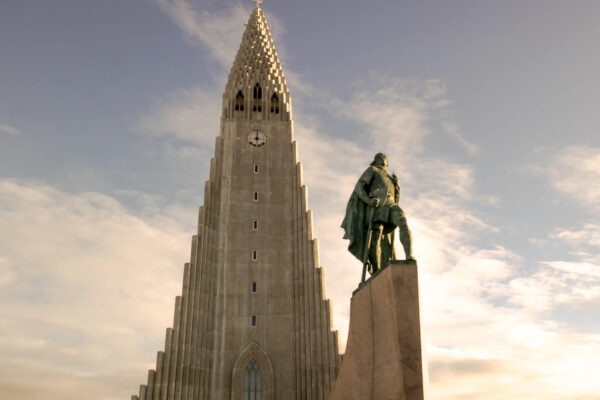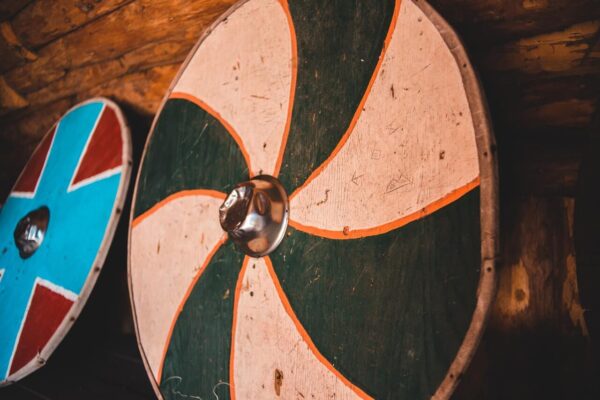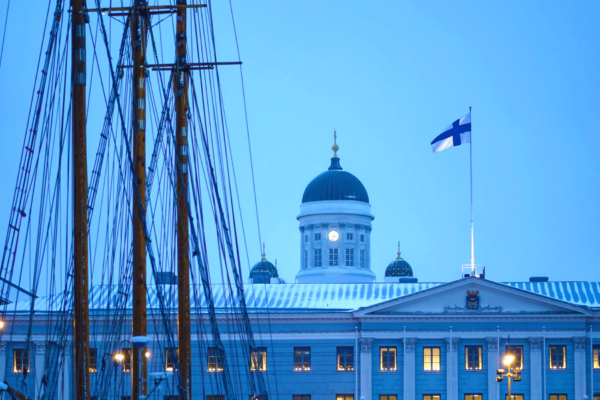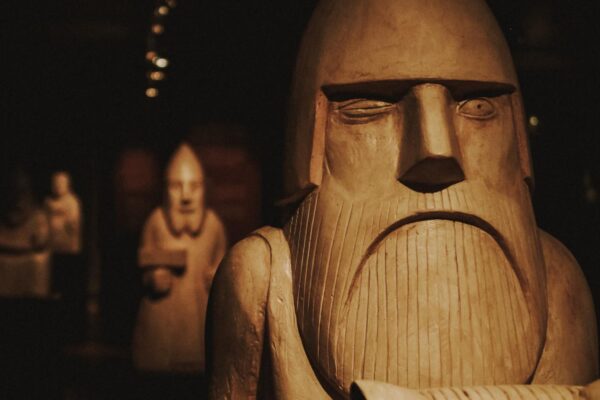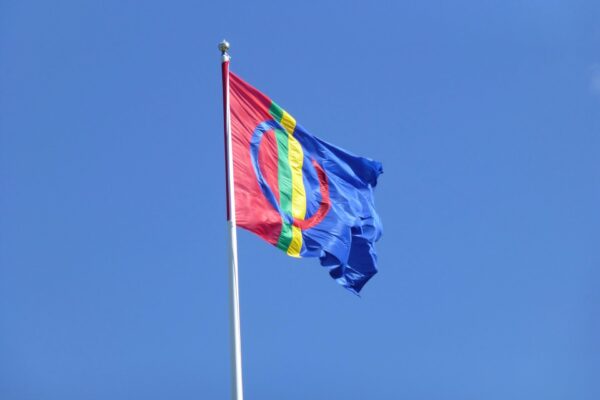When it comes to Denmark’s history, most people will first think of the Vikings – and in few other countries did the seafarers from the north have so much influence and power. But besides the Vikings, the history of the world’s oldest monarchy has much more to offer – here you can read all there is to know of the development of the northern European state over the centuries!
Denmark’s history begins early – hunters and gatherers were already travelling through the small country during the last Ice Age and the Stone Age. However, it was primarily the Viking Age between 800 and 1066 that helped Denmark gain power and still characterises its history today. The great Viking kings like Gorm the Old, Harald Bluetooth, Sweyn Forkbeard and Cnut the Great united Denmark under a single king and transformed the small country into a North Sea power.
In the Middle Ages, Denmark expanded its territory to include the Baltic Sea, but this repeatedly led to conflicts with the German Hanseatic League. In addition, the period of the unions began – first with Norway, then the Danish king ruled over all three Scandinavian countries within the Kalmar Union – therefore Danish history is closely linked to the history of Norway and Sweden. From the 17th century onwards, the end of the Union led to increasing tensions with the new Baltic power Sweden, which culminated in the Napoleonic Wars.
Subsequently, the Schleswig-Holstein question put the European order to the test. With the German-Danish War, Denmark lost an important territory to the German Confederation and turned to neutrality in the 20th century. During the Second World War, Denmark was occupied by Germany, but after the Allied victory, it was finally able to develop into the modern welfare state we know today.
From 17,000 BC: Danish Ice Age and Stone Age
The first people in Denmark
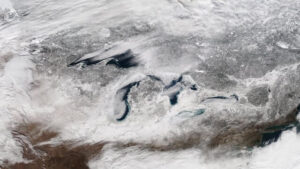
With the end of the last Ice Age from the 13th millennium BC, reindeer herds migrated to southern Scandinavia – followed by hunter-gatherers. Traces of these presumably first humans on Danish territory have been found in what is now southern Denmark.
The permanent settlement of Denmark probably began from 11,500 B.C. The so-called Bromme culture inhabited camps by lakes and rivers. Over the course of the millennia, there was mixing with other cultures, all of which were still hunter-gatherers.
Neolithic Age: Agriculture in Denmark

The first farmers probably arrived in Denmark from the south from 4000 BC. Agriculture changed the way of life of the first inhabitants – people became sedentary and the first social structures developed.
Traces of them can probably be found in the megalithic sites – large stone blocks erected in a specific pattern. The first burial mounds were also erected at this time.
1700-500 BC: Bronze Age
Cultural bloom
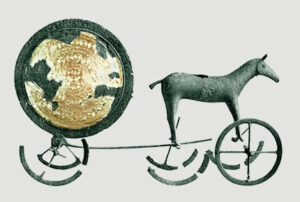
The Bronze Age saw a cultural boom in Denmark, which was mainly due to the milder and warmer climate. Finds from this period are often rich and splendid, such as the sun chariot from Trundholm – after further immigration and mixing of cultures, the prehistoric Danes also acquired bronze.
500 BC - 800 AD: Iron Age
6th century: North Germanic tribes arrive in Denmark
North Germanic peoples arrived in Denmark as part of the migration of peoples, particularly in the sixth century. They probably came from southern Sweden and mixed with or displaced the tribes living in Denmark. These ethnic groups are the ancestors of today’s Danes.
From 800: Viking Age
811: Agreement with Charlemagne
From around 768, there were increasing border conflicts between the pagan Danes and the Frankish Empire under the Christian rule of Charlemagne. After it looked as if a major war was on the horizon, internal power struggles among the Danes eventually led to a peace agreement.
In 811, the Treaty of Saints was signed, which officially defined the border between the Danish territories and the Franks. The southern border of the Danes was thus fixed at the River Eider – it remained valid until 1864.
The first Danish city
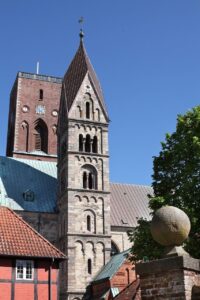
From 860, the first church in Scandinavia was built in Ribe under the Jutland Viking King Horik II. The settlement had already been inhabited before this, but developed into the country’s first real town and was one of the most important trading centres in Northern Europe.
The other most important town at this time was Schleswig, which is now in Germany, or Haithabu (now a Viking museum). The town was the first trading metropolis of the Vikings.
10th century: Gorm the Old “founds” Denmark

Gorm the Old is considered to be the first king of Denmark – at least he had the small rune stone of Jelling made, which is regarded as Denmark’s birth certificate and baptismal certificate and on which the name “Denmark” is mentioned for the first time.
He was also the founder of the Jelling dynasty and a distant ancestor of today’s Danish royal family and the current King Frederik X.
Harald Bluetooth
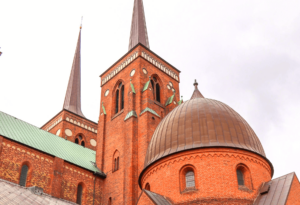
Gorm’s son Harald Bluetooth is considered one of Denmark’s most famous and greatest kings. Harald led many raids and conquered southern Norway, which also made him King of Norway. He was also the one who truly united Denmark under one crown.
Harald Bluetooth was baptised around the year 965. After bishoprics and monasteries had already been established in areas of Denmark, this was the official beginning of the Christianisation of Denmark. This is evidenced, for example, by the construction of Roskilde Cathedral – the city was founded by Harald Bluetooth as the royal seat and capital.
Sven Forkbeard & Knut the Great: Danish North Sea power
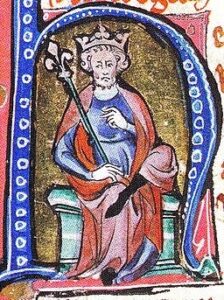
Under Harald’s successors, Denmark developed into a major power in the North Sea region. The Danish North Sea realm under Sven Forkbeard and Knut the Great included, besides Denmark, parts of Sweden, Norway and England. The rule over England by Danish kings lasted until 1042.
The Viking Age ended with the conquest of England by William the Conqueror in 1066. Haithabu was also destroyed and plundered by Norwegians and West Slavs.
Denmark in the High and Late Middle Ages
12th century: Waldemar the Great
Under the reign of King Waldemar I, who was the only Danish ruler besides Knut the Great to be given the epithet “the Great”, Denmark experienced a new heyday. Waldemar I had good relations with the great German rulers and laid the foundations for his rule in the Baltic region.
At the same time, he expanded defence walls and military installations in Denmark. He also made the monarchy in Denmark hereditary – after centuries, the elective kingship was replaced. A new, educated aristocratic class also emerged in the country and Denmark became the leading trading power.
Waldemar II and the Danish flag
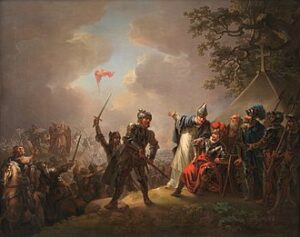
One of Waldemar the Great’s sons was Waldemar II, who followed his father’s vision and developed Denmark into a major power in the Baltic Sea region in the first half of the 13th century. This supremacy was only lost to the Hanseatic League in the middle of the 14th century.
The myth of the origin of the Danish flag also dates back to Waldemar’s reign. It is said that on 15 June 1219 at the Battle of Lyndanisse (Tallinn), a huge flag with a white cross on a red background fell from the sky and helped the king and his army to victory.
Conflicts with the Hanseatic League
Throughout the 14th and 15th centuries, there were numerous conflicts between Denmark and the Hanseatic League for supremacy in the Baltic Sea. After Denmark was initially able to assert its dominance, the Peace of Stralsund was concluded in 1369, confirming the Hanseatic League as the new ruler of the Baltic Sea.
Union with Norway
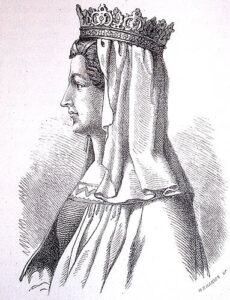
Denmark secured power over Norway in the 14th century through a skilful marriage policy. The Danish princess Margaret was married to the son of the King of Sweden and Norway. As Norway could no longer afford its own throne, Olav, Margaret’s son, who was already King of Denmark, was also crowned in Norway, which meant that Iceland and the Faroe Islands were also part of his territory.
Although Denmark and Norway were equal on paper, Denmark fully controlled Norway, which was ravaged by plague and poverty.
1397-1523: The Kalmar Union
1397: Negotiations in Kalmar
Regent Margaret pursued the goal of uniting all three Nordic monarchies into one. To this end, she summoned representatives from Sweden, Denmark and Norway to a meeting in Kalmar.
There, a letter of union stipulated that the three countries should pursue a common foreign policy. The first king of the Kalmar Union was Erik of Pomerania, Margaret’s great-nephew and heir, who had already been elected King of Denmark in 1390.
Denmark in the Union
As a result, Danish centralism prevailed. Denmark was the most powerful member of the Union and was able to dominate the other two countries. As a result, the already decimated Norwegian and Swedish nobility were pushed back further and further. Although there were repeated uprisings against the Danish kings, these were always put down.
Meanwhile, there was a cultural upswing in Denmark, whose capital was moved from Roskilde to Copenhagen in 1443. The first book was printed in 1482 and the first book in Danish appeared in 1495.
1523: The end of the Union
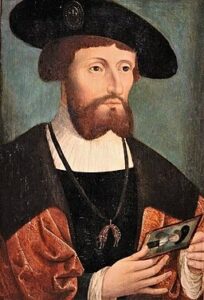
From the middle of the 15th century, Scandinavia was characterised by the Danish-Swedish and Danish-Hanseatic Wars, in which the Union kings repeatedly lost their rule over Sweden. This phase was ended by the final rise of Gustav Vasa, who successfully rebelled against the Danish King Christian II and had himself elected and crowned sole King of Sweden in 1523.
Sweden thus finally left the Union. However, the union of Denmark and Norway, to which Iceland also belonged, remained, as Norway still had no political power of its own. However, with Sweden rising to become a great power, a powerful new competitor for supremacy over the Baltic Sea now emerged.
Denmark in modern times
16th century: The Reformation reaches Denmark
The future King Christian III had attended the Diet of Worms in 1521 as a prince and became an ardent supporter of Luther there. He converted to Protestantism himself as a result and introduced the new religion in his duchy of Schleswig, from where it spread more and more in Denmark.
Christian was elected king in 1534, and in 1536 the Protestant faith was declared the sole state religion. The Reformation had thus largely spread peacefully in Denmark – but Christian did not leave it at that, but also had it enforced in Norway and Iceland.
17th century: Tensions with Sweden
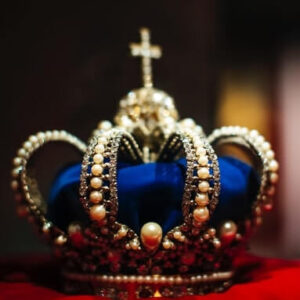
In terms of foreign policy, Denmark-Norway was primarily in conflict with Sweden at this time. There were repeated wars between the neighbouring countries. At first Denmark was able to maintain its supremacy, but in the 17th century the tide turned in Sweden’s favour and the country rose to become a great power in Europe.
Under King Christian IV, who established absolutism in Denmark, the country took part in the Thirty Years’ War between 1625 and 1629. The Danish military collapsed and large parts of the kingdom were lost to Sweden, although some of them were later regained. Nevertheless, Denmark had lost its dominant position on the Baltic Sea to Sweden.
In the years that followed, there were repeated military conflicts with Sweden, and in some cases Denmark was only able to secure its continued existence thanks to foreign aid.
The Great Northern War from 1700 to 1721 put an end to Sweden’s supremacy. Denmark-Norway fought alongside the new superpower Russia, but did not gain any territories itself. Instead, a policy of neutrality was adopted.
Danish Colonies
After Greenland had already been visited and colonised by Vikings, Inuit and whalers, Denmark declared itself the owner of the world’s largest island around 1700. The Danish colonisation of Greenland began in the 1720s and the following decades.
In addition to Greenland, between the 17th and 20th centuries Denmark also owned small colonies on Africa’s Gold Coast or what is now Ghana, in the Caribbean (“Danish West Indies”, the Lesser Antilles and the Virgin Islands) and in India (“Danish East Indies”). The colonies were mainly used to trade slaves, sugar cane and spices.
Denmark during the Napoleonic Wars
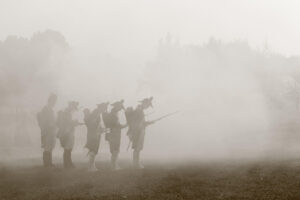
Denmark-Norway first became involved in the Napoleonic Wars (1792-1815) in 1801, but only really became active in 1807, when Great Britain secured the Danish navy in the course of the bombardment of Copenhagen. The loss of the ships not only meant a loss of protection, but also trade opportunities. Denmark abandoned its policy of neutrality and instead entered into an alliance with France – although the latter’s blockade of Great Britain caused great damage.
Sweden, on the other hand, was part of the coalition against France. From 1813 to 1814, there was a direct war between Denmark and Sweden, which Sweden won. In the subsequent Peace of Kiel, which was concluded on 14 January 1814, Denmark lost Norway to Sweden and the personal union came to an end. However, Iceland, Greenland and the Faroe Islands continued to belong to Denmark.
19th century: National movements and conflicts
First national movements and the flowering of literature
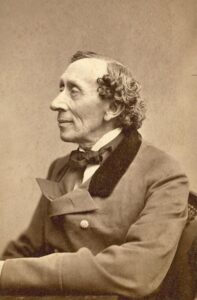
In the 19th century, the national movements also arrived in Denmark. The liberals gained more and more power – in 1848, Denmark’s Basic Law, which is still in force today, came into force and Denmark became a constitutional monarchy.
Denmark also enjoyed a literary heyday. Danish Romanticism is regarded as the golden age of Danish literature. It was characterised by the themes of longing, nature and mythology. Adam Oehlenschläger is probably the best-known author. A little later, Hans Christian Andersen, a representative of realism, probably the most famous Danish author in history, entered the world stage.
The Schleswig-Holstein Question I: The Schleswig-Holstein Uprising
Conflicts had already arisen around the duchies of Schleswig, Holstein and Lauenburg in the south of Denmark, as they stood between Denmark and Germany. Although the duchies belonged to the Danish state as a whole, Holstein and Lauenburg were also members of the German Confederation.
After the Danish state bankruptcy in 1813 and out of concern about the complete Danish incorporation of Schleswig, sympathisers with Germany rose up against the Danish royal house in 1848. The uprising was put down, but Schleswig was granted independence under constitutional law outside Denmark.
The Schleswig-Holstein Question II: The German-Danish War
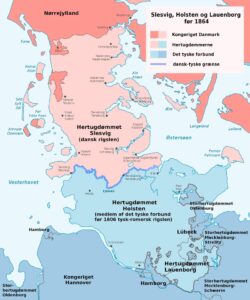
As a result, the situation did not ease – rather the opposite. After Denmark once again attempted to incorporate Schleswig with the November Constitution, Prussian and Austrian troops marched into Schleswig on 1 February 1864, triggering the Second Schleswig War and the German-Danish War.
Prussia and Austria quickly conquered Schleswig and the rest of Jutland. Denmark could only surrender, which is why the three duchies fell to the German Confederation at the end of the war and the Peace of Vienna on 30 October 1864. The border demarcation of 811 thus also became a thing of the past.
In Denmark, this devastating defeat and loss of territory had a profound impact on the development of national identity. As a result, politics moved to the left and a policy of neutrality was adopted.
20th and 21st century: The modern welfare state
Denmark in the early 20th century
At the beginning of the 20th century, Denmark developed a system of state regulation while continuing its neutral foreign policy. Denmark did not take part in the First World War, and a few Danes fought on the side of Germany. After this, a referendum was held in Schleswig – North Schleswig became part of Denmark again in 1920.
After the Easter Crisis and the chaos that ensued, the Social Democrats became head of government for the first time in 1924, leading Denmark out of the Great Depression and expanding the social welfare state.
Denmark in the Second World War: Under German occupation
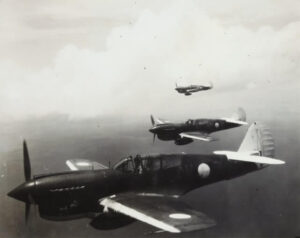
Denmark also wanted to maintain its neutrality during the Second World War and negotiated a non-aggression pact with the German Reich in May 1939. However, this did not prevent the German Wehrmacht from invading Denmark on 9 April 1940 as part of Operation Weserübung in violation of international law. By the evening, the militarily weak Denmark was completely occupied and capitulated.
Although Denmark was now under German control, it was at least formally able to maintain its sovereignty. Unlike many other occupied countries, the government and the head of state, King Christian X, remained in the country, and the parliament, army and navy also remained intact until 1943.
It was not until the end of 1942 that resistance in Denmark to the occupying forces increased noticeably. During the August Revolt in 1943, there were a series of civil strikes and riots. When the Danish government also defied the German occupiers, it was deposed and a state of emergency was declared. The Danish army was also disbanded.
A period of terror followed. The police and security apparatus were expanded, while at the same time resistance grew on the Danish side. When deportations of Jewish citizens were to take place in Denmark in October 1943, these plans were thwarted and around 7,200 of the 7,800 Danish Jews were brought to safety in neutral Sweden.
In 1944, Iceland became independent from powerless Denmark. Before that, they had only been in a personal union anyway.
The German occupiers remained in Denmark until May 1945, and on 4 May the Wehrmacht surrendered to Great Britain in north-west Germany, the Netherlands and Denmark. Denmark officially regained its freedom on 5 May.
The post-war years: Denmark’s rise to a modern welfare state

After the end of the Second World War, Denmark built on its international relations. The country was a founding member of the United Nations (1945), NATO (1949) and the Nordic Council (1952). It also joined the European Community in 1973 and became part of the European Union in 1993.
In 1953, a constitutional amendment was also introduced, which abolished the bicameral system and made the Folketing the only chamber in parliament. In addition, female succession to the throne was now possible, with Margrethe II becoming the first crowned queen to ascend the Danish throne in 1972.
Part of the constitutional amendment was also the abolition of colonies. The Faroe Islands have had extensive rights to self-determination since 1948. Greenland was granted self-government and autonomy in 1979. This independence status was further extended in 2009. Both territories continue to belong to the Kingdom of Denmark.
This is how Denmark developed into the modern and social state we know today. In 1989, Denmark became the first country in the world to introduce civil partnerships for homosexuals. In 2011, Helle Thorning-Schmidt of the Social Democrats became the first woman to head the Danish government.
